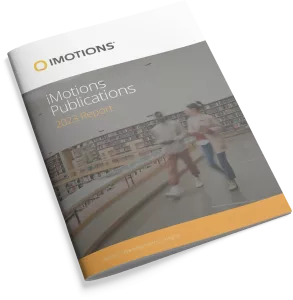-
Thin-Slice Measurement of Wisdom
Abstract: Objective Measurement of Wisdom within a short period of time is vital for both the public interest (e.g., understanding a presidential election) and research (e.g., testing factors that facilitate wisdom development). A measurement of emotion associated with wisdom would be especially informative; therefore, a novel Thin-Slice measurement of wisdom was developed based on the […] -
In Harm’s Way: On Preferential Response to Threatening Stimuli
Abstract: Given the evolutionary significance of survival, the mind might be particularly sensitive (in terms of strength and speed of reaction) to stimuli that pose an immediate threat to physical harm. To rectify limitations in past research, we pilot-tested stimuli to obtain images that are threatening, nonthreatening-negative, positive, or neutral. Three studies revealed that participants (a) […] -
Enhancing Student Models in Game-based Learning with Facial Expression Recognition
Abstract: Recent years have seen a growing recognition of the role that affect plays in learning. Because game-based learning environments elicit a wide range of student affective states, affect-enhanced student modeling for game-based learning holds considerable promise. This paper introduces an affect-enhanced student modeling framework that leverages facial expression tracking for game-based learning. The affect-enhanced […] -
Music Recommendation System for Human Attention Modulation by Facial Recognition on a Driving Task: A Proof of Concept
Abstract: The role of music on driving process had been discussed in the context of driver assistance as an element of security and comfort. Throughout this document, we present the development of an audio recommender system for the use by drivers, based on facial expression analysis. This recommendation system has the objective of increasing the […] -
Towards More Robust Automatic Facial Expression Recognition in Smart Environments
Abstract: In this paper, we provide insights towards achieving more robust automatic facial expression recognition in smart environments based on our benchmark with three labeled facial expression databases. These databases are selected to test for desktop, 3D and smart environment application scenarios. This work is meant to provide a neutral comparison and guidelines for developers […] -
Facial Expressions to Evaluate Advertising: A Laboratory versus Living Room Study
Abstract: In recent years researchers have shown growing interest in the impact of emotions in television commercials and in advertising in general (Park and Thorson, 1990). Emotions also influence the attitude towards the brand and to the ad (Batney and Ray, 1986; Edell and Burke, 1987; Derbaix, 1995), increase the attention of the advertisement (Olney, […] -
Inhabitable space control for the creation of healthy interactive spaces through emotional domotics
Abstract: In recent years, Mexico’s level of different physiological and mental negative states, such as stress have increased. This has among its consequences, low work production and social problems including the alarming numbers that nearly 43% of adults report high levels of stress. The increase of stress incidence in people aged 15–29 years, and the lack […] -
Emotional Effects Induced by Lip Balms Containing Different Emollients: Neuroscientific Approach to Studying the Tactual Experience
Abstract: Companies rely on traditional market research, e.g. consumer tests and focus groups, for predicting consumer compliance. Since they investigate the conscious perception of a product, their results can be one of the causes of the high failure rate (40%) of products after the launch. In recent years, experts in neurology, psychology and neuroscience have demonstrated […] -
Wearable Gaze Trackers: Mapping Visual Attention in 3D
Abstract: The study of visual attention in humans relates to a wide range of areas such as: psychology, cognition, usability, and marketing. These studies have been limited to fixed setups with respondents sitting in front of a monitor mounted with a gaze tracking device. The introduction of wearable mobile gaze trackers allows respondents to move freely […] -
Workflows and individual differences during visually guided routine tasks in a road traffic management control room
Road traffic control rooms rely on human operators to monitor and interact with information presented on multiple displays. Past studies have found inconsistent use of available visual information sources in such settings across different domains. In this study, we aimed to broaden the understanding of observer behaviour in control rooms by analysing a case study […]
Research Report 2024
In-depth look at the scientific landscape as powered by iMotions software, showcasing groundbreaking research and the impact of our tools in various scientific and industrial fields.

iMotions Science Resources
Looking for white papers, validation reports or research show casing iMotions Multimodal capabilities?
Share Your Research

850+ universities worldwide with an iMotions human behavior lab
73 of the top 100 highest ranked universities
710+ published research papers using iMotions
iMotions is used for some of the most interesting human behavior research studies carried out by top researchers around the world. Contact us to have your publication featured here.
The authors of these publications have used iMotions as a software tool within their research.
“Software should be cited on the same basis as any other research product such as a paper or a book; that is, authors should cite the appropriate set of software products just as they cite the appropriate set of papers” (Katz et al., 2020).
We therefore encourage you to cite the use of iMotions where appropriate.
How to cite iMotions
APA
iMotions (10), iMotions A/S, Copenhagen, Denmark, (2024).
Note: adjust the version and year where relevant.
5 Most Popular Blogs
Publications
Read publications made possible with iMotions
Blog
Get inspired and learn more from our expert content writers
Newsletter
A monthly close up of latest product and research news


